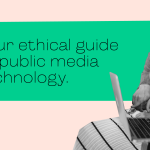
WGBH Case Study Two
Interview with Robert Kempf
March 2020
WGBH is a public media organization based in Boston, the largest producer of content for PBS, and a member of National Public Radio (NPR). It’s output not only includes radio broadcast, but podcasts, apps, television and events. It prioritizes content and journalism that serves the public interest and seeks to broaden knowledge across news, education, science, history and culture. It was a co-producer of the Bafta award-winning and Oscar-nominated documentary ‘For Sama’ in 2019, and has won numerous other awards for its journalism. Robert Kempf is the Vice President for Digital Services at WGBH.
What’s been the most significant tech strategy decision you’ve made in the last 12 months or so?
We’re involved in a larger public media initiative that started a few years ago. I’m part of a core group that is known as the Digital Infrastructure Group, or DIG for short. It’s a cohort of digital leaders from PBS, NPR, WGBH, KQPD and CPB, the Corporation for Public Broadcasting.
Our goal is to find infrastructure solutions that could be rolled out through public media at scale, and secure funding. It’s an idea that went from bar room to boardroom – I was talking to a colleague from another station at a conference, and we were bemoaning the fact that there was no federal funding or appropriation for digital infrastructure. There’s a part of a $450 million budget for community service grants – money for station revenues that’s distributed to public television and public radio stations. For WGBH it’s about 5% of our operating revenues, but if you’re a sole service in Alaska, it’s what allows you to function, and it’s foundational to how the public media system works in the US. There’s also money dedicated to supporting traditional broadcast infrastructure. There’s one for TV administered by PBS, and one for radio administered by NPR. But there’s no similar funds for digital public media infrastructure.
My colleague and I were saying – this doesn’t make sense, we’re in a digital age and we’re struggling as individual stations in making technology investments, burning operating capital or capital expenditure, where we could create an interesting collaborative list of digital infrastructure options. It’s not that we wouldn’t continue to make individual choices, but there are certain aspects of the digital stack that we could look at collectively.
We took an agile approach, and brought in some consultancy that did an assessment of public media systems, what’s around, what’s being spent locally – it became a big audacious vision with a $50 million spend. We needed to look at what was achievable and establish a starting point. Our priorities developed to be in three areas: SSO (single sign ons/registration services); CMS (Content Management Systems); and CRM (Customer Relationship Management) and data associated business intelligence and data management. We wanted to start with the cheapest and least controversial, and thought that would be SSO. In parallel, we were able to find some federal appropriation dollars from the infrastructure funds that now supports the work of these three initiatives. With SSO we’re in the final stages of a contract with Akamai.
It’s important to us, because our business model is predicated on membership, and this is such a huge part of what drives public media economics – being able to cultivate our current membership. But also looking at how we develop new audiences, getting from unknown anonymous users to known users, and creating a better user experience.
A big part of our vision is how do we make it easier for consumers of public media to have more personalized experiences and migrate across a public media landscape – whether this is from a local WGBH to PBS or NPR – with a sense of trust, knowing what their preferences are, and their membership status. We now have a prototype, but very few stations are using registration. We are at WGBH – for $60 a year it gives users access to the PBS catalog, and we are looking at ways to enhance this. One of the ways is capturing user data from Passport – PBS’ membership service. When we have data from Passport we’re then able to personalize experiences a bit more as we can see user’s content preferences.
I think larger public media organizations are thinking, okay, if I have registration, what kind of user services and value could I unlock? It becomes really interesting when you think about a public media ID that is essentially portable, controlled by the local entity, but with the user’s permission – you can start to develop a really rich profile and a really interesting way of serving a public media audience.
For content management systems, it’s an exercise that we in media organizations seem to repeat every few years and at great expenditure, in isolated ways. There’s nothing wrong with open source, WordPress and Drupal are great, but completely non-scalable, and an inefficient way to approach an area of infrastructure where there’s a tremendous amount of commonality. This is partly what DIG is about – where can we remove a tech burden and allow the scarce resources we have in local public media – and actually even national public media – to focus more on innovation, whether this is product innovation or user experience innovation.
A single CMS platform can really help public media in the US. It removes infrastructure friction, it means editors at different stations can co-write, collaborate, and distribute content much more seamlessly, it allows us to focus on the journalism, and content development, and the things we’re good at as a network.
I decided at WGBH that I didn’t want to build another CMS here. We’ve got 20 odd software engineers, we already do a lot of platform development for our national television productions. So there are people here who can do it, but I felt we were better served to outsource the work to a company that builds, manages and supports CMS products. I would rather pay money to do this so we can focus our internal energies on innovation, so we decided to use Brightspot. They support some pretty big media organizations, like Univision, Politico, The LA Times, and non-media like Sothebys. A single CMS platform can really help public media in the US. It removes infrastructure friction, it means editors at different stations can co-write, collaborate, and distribute content much more seamlessly, it allows us to focus on the journalism, and content development, and the things we’re good at as a network.
When you’re building these technologies out of DIG, do you have any plans to spin out your products publicly so other public media organizations could use them?
We’d like to think so. But we need to get our own organizations on board first. NPR is currently rolling out the Brightspot platform with affiliate stations – it will replace NPR’s own CMS this year. Then the larger stations, ourselves included, will be changing towards the end of 2020. PBS is supportive of the initiative, but they’ve just switched from Bento (PBS’s own CMS) version 2 to version 3, and are kind of loath to have their smaller stations moving platforms again at this point. This is sad, partly because what we’re doing is funded – not the customization, but the baseline platform, the licensing fee, hosting, migration – so the costs that stations have to bear on their own are now funded.
So what’s next? You’ve got the initial shopping list of SSO, CMS and CRM. Are there other products you’re thinking of adding?
So we haven’t gotten past CRM yet, but it’s a big one and a tough one. It’s in the early stages. We’re structured as independent nonprofits each with their own CRMs. It’s where we cultivate our memberships, so it’s super important – it’s like the treasure chest for each organization – so the politics of a centralized approach to CRM is really fraught. A centralized data lake would mean data at scale, and we could do much more effective user analytics work. Even in our little public media world we could develop some scale that could be interesting.
But we face a legacy model of ‘my members are my members’. I’m coming at it as a digital person, what makes sense in terms of tech and what you can do with data. But I’ve come to appreciate that the business concerns might be different. So we need to find areas of commonality, and if there are ways we can defray CRM costs as a group. For example, Salesforce is a big CRM player, they have products like NGOC, a more non-profit fundraising customization of Salesforce. They’re now migrating this into another product called NPSP – Non-Profit Success Pack. You’ll find a lot of public media entities are looking at NPSP as a fundamental tool. Could there be a single enterprise install for all of public media though? I don’t think this will happen in my lifetime, but there could be real economies of scale, informing product development at scale if we all worked with Salesforce in a coordinated way.
Our goal is omni-channel marketing, so we need to figure out how we run a data analytics system that can run effective campaigns across different platforms.
There’s also the data management and marketing automation stack, and that’s a hodgepodge of tools and systems. Some are integrated with Salesforce, some are digital only, and some allow predictive analytics for cross-platform marketing, which is what we do here, as we still do a lot of mail, television pledges and even canvassing. Our goal is omni-channel marketing, so we need to figure out how we run a data analytics system that can run effective campaigns across different platforms. We’re not there yet, but this is the way we’re thinking about it. Also, how do we more effectively unlock the power of the two national networks and their massive audiences? Most public media audiences are on PBS or NPR platforms. PBS is a little ahead of the game because of their mobile app, the nature of long-form programming and the Passport initiative, which has agreements for data sharing between them and stations.
At DIG, we’ve now called together a group of people who are experts at either their own CRMs or membership and fundraising to assess the requirements for any CRM initiative. But we’ve reached the point now where we need a consultant to assess the pieces of infrastructure already out there and make some recommendations. For example, PBS has built a piece of tech called M Volt. Stations upload their member files to say if a user is a member at the Passport level of $60 or not. If yes, then M Volt issues a token, which then unlocks the PBS catalog. It’s very simple but could be used for more across the public media system. We need some assistance in figuring this out.
Can we go back to the point you made at the beginning about funding for collaborative tech infrastructure? We’re seeing initiatives from the big tech platforms to support journalism, but little investment from them or foundations for tech infrastructure.
How do we approach it in a way where we aren’t losing or diminishing a direct relationship with our audience?
We have a whole team that raises money from foundations and it’s all for content. Then we have to spend X amount on paid social, and really incredibly inefficient ways of raising awareness of this content by buying attention from the big tech platforms. There’s a big piece of work at DIG, that we don’t have the answer too yet – when living on distributed platforms, when doing in-depth negotiations with the Googles and Facebooks etc, how do we approach it in a way where we aren’t losing or diminishing a direct relationship with our audience.

Robert Kempf
Vice President for Digital Services at WGBH

